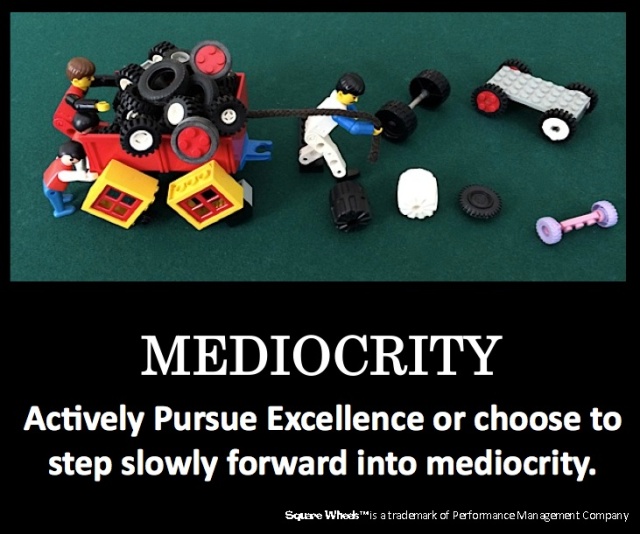Dan Rockwell shared another good post, this one on pursuing excellence and dealing with mediocrity. Ever since Tom Peter’s and Bob Waterman published In Search of Excellence (1982), I have found that concept to be a really solid and inspiring one to use. And one does not often hear the word “excellence” used much these days when talking about leadership or organizational improvement. Those thoughts of Peter’s have been strong influencers of my work for the past 30 years, the things like MBWA and sticking to the knitting.
Dan’s summary bullets included these:
- Ask teams, who believe in the mission, where they can be better. Don’t point out their failures. Let them point out their aspirations.
- Every time you feel like pointing out a problem, ask, “How can we make that better?”
- Never allow conversations about issues or problems to end without finding some corrective action. At the least, set a “make it better” meeting.
- Ask, “What can we do about that,” when someone points out a problem or shortfall.
- Reject the need for big solutions. The need for big solutions is the reason teams end up doing nothing, except complaining.
- When someone says, “That won’t work,” ask, “What might help?”
- Focus more on where you’re going than where you’ve been. Apply Pareto’s 80/20 principle.
- Think of the pursuit of excellence in terms of people, then systems. How can you maximize talent and passion?
(You can find Dan’s whole list here)
While the Excellence book did get panned because of some of the companies they selected, the principles that Peters and Waterman expressed seemed really solid ones and I think if more companies did these kinds of things, we would probably see higher levels of employee engagement and innovation today. Those eight key points, taken from the Wikipedia article, are:
- A bias for action, active decision making – ‘getting on with it’. Facilitate quick decision making & problem solving tends to avoid bureaucratic control
- Close to the customer – learning from the people served by the business.
- Autonomy and entrepreneurship – fostering innovation and nurturing ‘champions’.
- Productivity through people- treating rank and file employees as a source of quality.
- Hands-on, value-driven – management philosophy that guides everyday practice – management showing its commitment.
- Stick to the knitting – stay with the business that you know.
- Simple form, lean staff – some of the best companies have minimal HQ staff.
- Simultaneous loose-tight properties – autonomy in shop-floor activities plus centralized values.
Most of these are people / philosophy issues, as I see them. And people ARE about performance!
My personal approach for the past 20+ years is to view people and performance issues within the realm of my Square Wheels frameworks, which I think meld really nicely with Dan’s thinking. Languaging around Square Wheels for issues and Round Wheels for possibilities takes a lot of the negative out of improvement discussions, since we can all accept that the Square Wheels are everywhere and the Round Wheels already exist.
So here is a little ditty on Mediocrity that I spun up for this blog.
Don’t let all those Round Wheels seem like roadblocks to your performance improvement or your journey forward. There are ideas for performance improvement everywhere and managing improving excellence is a simple process of working with people with a degree of alignment and collaboration.
For the FUN of It!
 Dr. Scott Simmerman is a designer of team building games and organization improvement tools. Managing Partner of Performance Management Company since 1984, he is an experienced presenter and consultant.
Dr. Scott Simmerman is a designer of team building games and organization improvement tools. Managing Partner of Performance Management Company since 1984, he is an experienced presenter and consultant.
Connect with Scott on Google+ – you can reach Scott at scott@squarewheels.com
Follow Scott’s posts on Pinterest: pinterest.com/scottsimmerman/
Scott’s quips and quotes on Poems on The Workplace is here.
Square Wheels are a trademark of Performance Management Company
LEGO® is a trademark of The LEGO Group
